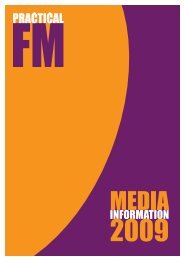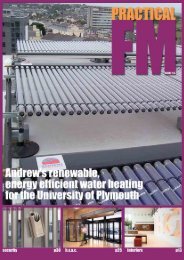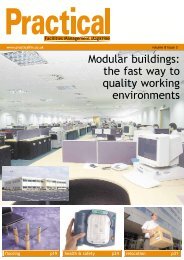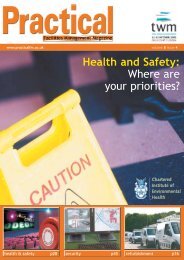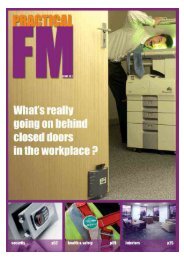Apollo Fire Detectors protect Leadenhall Market Apollo Fire ...
Apollo Fire Detectors protect Leadenhall Market Apollo Fire ...
Apollo Fire Detectors protect Leadenhall Market Apollo Fire ...
You also want an ePaper? Increase the reach of your titles
YUMPU automatically turns print PDFs into web optimized ePapers that Google loves.
RR: 85115<br />
24<br />
fire & hazard <strong>protect</strong>ion<br />
Firing up the changes<br />
Tony Morris of Casella Winton discusses the<br />
impending changes to <strong>Fire</strong> Regulations in the UK<br />
The long awaited review of existing<br />
UK fire legislation comes to a<br />
conclusion next year with the<br />
introduction of “The Regulatory<br />
Reform (<strong>Fire</strong> Safety) Order<br />
2006.” It is anticipated that the<br />
order will come into effect in<br />
early April 2006, initially applying<br />
only to England and Wales, with<br />
Scotland and Northern Ireland following<br />
suit via their own statutes<br />
in due course.<br />
Already out in draft format, it is<br />
proposed that the order will revoke<br />
all existing fire legislation, including<br />
the ‘<strong>Fire</strong> Precautions Act 1971’<br />
and the ‘<strong>Fire</strong> Precautions<br />
(Workplace) Regulations 1997/9,<br />
together with the other hundred or<br />
so odd pieces of local fire enactments,<br />
by-laws, and peripheral<br />
orders.<br />
Subsequently, fire certification will<br />
become a thing of the past, however<br />
bear in mind that the current<br />
requirements remain firmly in<br />
place until revoked by the new<br />
order. Sound advice is therefore to<br />
maintain the building in accordance<br />
with the current fire certificate,<br />
continue to consult with the fire<br />
officer as and when required and to<br />
maintain an up-to-date set of single<br />
line drawings for the workplace<br />
and, where appropriate, relevant<br />
building(s).<br />
Designed to harmonise with the<br />
current framework and format of<br />
Heath & Safety legislation, the<br />
order is similar in every respect to<br />
the existing <strong>Fire</strong> Precautions<br />
(Workplace) Regulations 1997/9<br />
and applies (with the similar exceptions<br />
of domestic premises and outdoor<br />
locations) to all places of<br />
work.<br />
As expected, the order will place a<br />
requirement on the employer as<br />
the ‘Responsible Person’, to<br />
appoint a ‘Competent Person’ to<br />
undertake a meaningful and realistic<br />
fire risk assessment appropriate<br />
to the size and nature of the workplace.<br />
There is renewed emphasis<br />
on the role of the employer as the<br />
‘Responsible Person’ in the workplace,<br />
or on the person who has any<br />
degree of control over all or part of<br />
the building. The ‘Responsible<br />
Person’ will be accountable by law<br />
for compliance with the order and<br />
will be required to appoint one or<br />
more ‘Competent Persons’ to carry<br />
out the risk assessment and implement<br />
the measures within the<br />
workplace.<br />
There is also a proposal to introduce<br />
a third category of person into<br />
the order - namely the ‘Relevant<br />
Person.’ This category has been<br />
introduced deliberately to take<br />
into account those persons who<br />
currently fall outside the immediate<br />
jurisdiction of an ‘Employer’<br />
but who may be affected by (or<br />
may influence by their own activities)<br />
the risk within the workplace.<br />
This category is further extended<br />
to include those persons who may<br />
lawfully be on, under or in the<br />
vicinity of the workplace and/or<br />
relevant building(s), i.e. General<br />
Public, Visitors, Contractors,<br />
Residents, Neighbours, etc.<br />
Emphasis is also made of the need<br />
to undertake specific fire risk<br />
assessments where there is:-<br />
A ‘Child’ employed (being not over<br />
school age as defined i the<br />
Education Act 1996).<br />
‘Dangerous Substances’ present in<br />
the workplace (as defined under<br />
the H&S ‘Approved classification<br />
and labelling guide’)<br />
A possibility of ‘Serious and<br />
Imminent Danger’ arising through<br />
fire or similar event in the workplace.<br />
In such cases the<br />
‘Responsible Person’ must establish<br />
enhanced procedures to pre-warn<br />
staff of the risk, increase safety<br />
training and fire drills, implement<br />
measures to minimise the risk,<br />
install additional means of escape<br />
provisions where necessary, and<br />
take steps as necessary to ensure<br />
an immediate evacuation<br />
before.....<br />
Other ‘Articles’ reiterate the existing<br />
workplace regulations, emphasising<br />
the provision and maintenance<br />
of means of escape facilities,<br />
the maintenance of all fire related<br />
equipment (portable, fixed, and<br />
that provided for fire-fighters use),<br />
staff training, record keeping and<br />
regular reviews of the fire risk<br />
assessment.<br />
There is also an interesting addition<br />
in the draft order regarding ‘<strong>Fire</strong>-<br />
Fighters Switches’ whereby it is<br />
proposed that the ‘Responsible<br />
Person’ should register any existing<br />
switches within 21 days of the<br />
order, or consult with the fire<br />
authority over any proposed installation.<br />
The wording within the<br />
draft order refers specifically to<br />
switches that isolate high voltage<br />
luminous discharge signs, and not<br />
to the more common fluorescent<br />
lighting, used to illuminate modern<br />
facia signs.<br />
One thing that employers should be<br />
aware of is an enhanced policy of<br />
validation and enforcement by the<br />
fire authorities. The <strong>Fire</strong> Service<br />
College has been running (and will<br />
continue to do so for some time)<br />
specific fire risk assessment courses<br />
for both external delegates and<br />
local authority fire officers. The<br />
contents of the courses deliberately<br />
focus on levels of ‘assessor’ competency,<br />
benchmark standards,<br />
contents and compilation, and the<br />
validation and enforcement<br />
aspects. From our own experience,<br />
fire officers around the country<br />
have been looking far more closely<br />
at fire risk assessments to ensure<br />
they are appropriate, meaningful<br />
and realistic, taking into account<br />
the size, nature of activities, number<br />
of persons, and fire risks within<br />
the workplace.<br />
Casella Winton’s ‘<strong>Fire</strong> Risk<br />
Assessment’ policy has been<br />
extended over the last couple of<br />
years in anticipation of the new<br />
order. Any changes or additions to<br />
the proposals will of course be<br />
evaluated when known and circulated<br />
to our clients and website<br />
‘Help Desk’.<br />
Reader Reply No.: 85128<br />
www.practicalfm.co.uk





